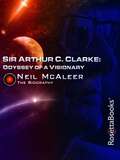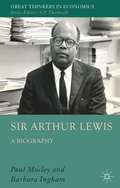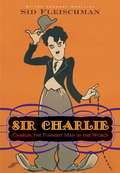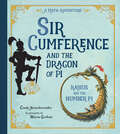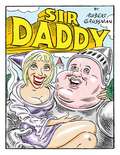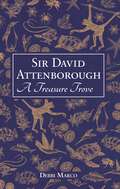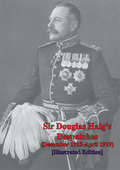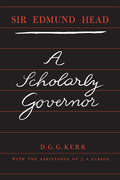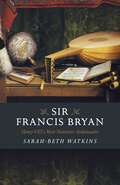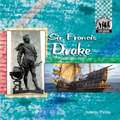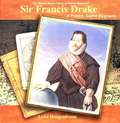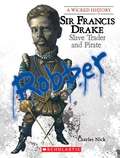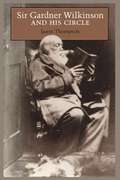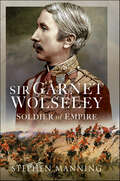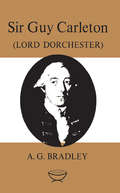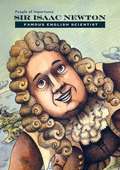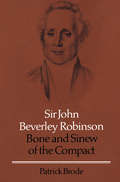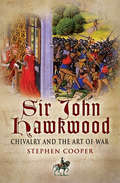- Table View
- List View
Sir Arthur C. Clarke: A Biography
by Neil McaleerWith over 100 books in publication, Sir Arthur C. Clarke is one of the world's most renowned science fiction writers and winner of every award available in the genre-and this is the only complete biography of his life. This detailed and surprisingly intimate biography takes readers behind the scenes during Clarke's famous collaboration with Stanley Kubrick on the classic film 2001: A Space Odyssey. It also highlights the visionary scientific concepts he imagined in his books-many of which later became reality.This edition includes forewords by Ray Bradbury and Walter Cronkite as well as a special foreword for this first ebook edition by the author and is a substantial revision of the 1992 publication Arthur C. Clarke: The Authorized Biography, containing expanded material detailing the author's early life and last two decades. A unique chronicle of one of the founders of the science fiction genre, this is the most current and comprehensive biographical reference on the author, inventor, and futurist.
Sir Arthur Lewis: A Biography (Great Thinkers In Economics)
by Paul Mosley Barbara InghamSir Arthur Lewis.
Sir Charlie: Chaplin, the Funniest Man in the World
by Sid FleischmanThe story of Charlie Chaplin --the brightest Hollywood star, ablaze in movie astronomy, and by common consent, "the funniest man in the world."
Sir Cumference and the Dragon of Pi (Sir Cumference)
by Cindy NeuschwanderFor fans of the Sir Cumference series with Pi on their mind, here is the second installment in this fun look at math and language. This time the math adventure is centered around a potion that changes Sir Cumference into a fire-breathing dragon. Can Radius change him back? Join Radius on his quest through the castle to solve a riddle that will reveal the cure. It lies in discovering the magic number that is the same for all circles. Perfect for parent and teachers who are looking to make math fun and accessible for everyone.
Sir Daddy
by Robert Grossman Dennis HofLegendary comic artist Robert Grossman presents a warts-and-all comic book on the life of Dennis Hof--author of The Art of the Pimp, America's King of Sex, the P.T. Barnum of booty, the whoremonger with a heart of gold.Sir Daddy illustrated by Robert Grossman offers a sneak peek at the hilarious and shocking life of Dennis Hof, author of The Art of the Pimp, on sale now! In The Art of the Pimp, Hof offers a laugh-out-loud, insightful, behind-the-scenes look at life as the proprietor of The Moonlight BunnyRanch, the world's most famous legal brothel, and recounts his chaotic life as the king of America's sex industry. Hof, the star of HBO's critically lauded series Cathouse, reveals the tricks of turning tricks, the secrets of his outrageous marketing stunts, and scandalous details of his friendships with porn stars, prostitutes, and politicians. Readers will learn how Hof's "girls" negotiate the highest prices for sex, the dirty little secrets of getting men to fall in love with them, and the inside tales of "The Girlfriend Experience," the #1 requested menu item. The Art of the Pimp will take readers on a wild ride through his countless sexual conquests, romantic failures, and business successes.
Sir David Attenborough: A Celebration of a British Icon
by Summersdale PublishersCelebrate our most beloved broadcaster, biologist and environmentalist with this stunning gift book, packed to the brim with facts, trivia questions and a selection of his most insightful and inspiring quotesSir David Attenborough has spent a lifetime inspiring, educating and delighting viewers of all ages with his pioneering wildlife documentaries and his appreciation for the wonders of the natural world. His passion, knowledge and authority - as well as his deep sense of humanity - have made him one of the most respected and beloved icons of our time. He has also used his platform to help raise awareness of the plight of our wildlife, being a tireless advocate for conservation and the environment.This collection of his wisest and most inspirational quotes, along with eye-opening facts and trivia, is a must-have for any Attenborough afficionado. Dive into a celebration of the incredible richness of the natural world around us, from the majesty of the animal kingdom to the awe-inspiring depths of the oceans, and discover a hopeful outlook for the future, through David Attenborough's eyes.
Sir Douglas Haig's Despatches (December 1915-April 1919) [Illustrated]
by Field-Marshal Earl Douglas HaigField-Marshal Haig commanded the British Empire forces through from 1915 to 1919; his period in charge of the men under his command has been the subject of much debate ever since the First World War ended. To some he was a "Butcher" overseeing the bloodbaths of the Somme and Passchendaele, to others he was a stoic leader faced with almost insurmountable difficulties of the warfare of the age. Whichever opinion holds sway in the public psyche, his despatches from the front, are gripping reading that drive to the heart of his character. Often fulsome of praise for the men under his command, Haig was reticent to give vent to failures in public; the despatches are very revelaing, whilst capturing all of the swings of fortune on the Western Front.Author -- Field-Marshal Earl Haig, Douglas, 1861-1928.Text taken, whole and complete, from the edition published in London, J.M. Dent & sons ltd.; 1919.Original Page Count - xvii and 378 pagesIllustrations -- 10 maps and Illustrations.
Sir Edmund Head: A Scholarly Governor
by Donald Kerr James GibsonA century ago, in 1854, Sir Edmund Head became governor general of Canada. His earlier career as Oxford don, chief Poor Law commissioner during the "hungry forties," and lieutenant-governor of New Brunswick, had prepared him to succeed Lord Elgin in this senior post in the British colonial service. Combining the outlook and training of a scholar with a long administrative experience in difficult posts, Head had a clear insight into British North American problems, and was able to guide British and Canadian politicians toward their solution in the creation of the new Dominion of Canada. Later, as Governor of the Hudson's Bay Company, he carried negotiations for the transfer of the Company's territories to the verge of conclusion before his sudden death in 1868. Neglected until recently by Canadian historians, the significance of the work of one of Britain's greatest colonial administrators is only now beginning to be appreciated. Professor Kerr's biography creates a lively and convincing picture of Head and colonial life at a critical period. Based on careful research among the public documents of the period, and making use as well of Head's private letters to close friends in England and North America, it is the first full-scale treatment available of this philosophic and capable governor whose influence on Canadian national development was so important.
Sir Francis Bryan: Henry VIII's Most Notorious Ambassador
by Sarah-Beth WatkinsSir Francis Bryan was Henry VIII's most notorious ambassador and one of his closest companions. Bryan was a man of many talents; jouster, poet, rake and hell-raiser, gambler, soldier, sailor and diplomat. He served his king throughout his life and unlike many of the other men who served Henry VIII, Bryan kept his head and outlived his sovereign. This book tells the story of his life from coming to court at a young age through all his diplomatic duties to his final years in Ireland. The latest book from the best-selling author of Lady Katherine Knollys: The Unacknowledged Daughter of King Henry VIII
Sir Francis Drake
by Dr John SugdenHow well do you know the life of one of Britain’s great maritime heroes? Discover the truth behind a man who remains a legendary figure of history more than four hundred years after his death.Sir Francis Drake’s career is one of the most colourful on record. The most daring of the corsairs who raided the West Indies and Spanish Main, he led the English into the Pacific, and cirumnavigated the world to bring home the Golden Hind laden with Spanish treasure. His attacks on Spanish cities and ships transformed his private war into a struggle for surivival between Protestant England and Catholic Spain, in which he became Elizabeth I's most prominent admiral and marked the emergence of England as major maritime nation.‘Excellent...It deserves to become the standard Drake life. His scholarship is impeccable’ Frank McLynn, Sunday Telegraph
Sir Francis Drake
by Kristin PetrieA biography of the English seaman and explorer who was knighted by Queen Elizabeth I.
Sir Francis Drake: A Primary Source Biography (Primary Source Library Of Famous Explorers)
by Lynn HoogenboomDetails the life and exploits of Sir Francis Drake, an early English slave-trader and pirate who successfully sailed around the world.
Sir Francis Drake: Slave Trader and Pirate
by Charles NickWhat sight sent shivers down the spines of 16th-century Spanish sailors? The masts of any ship belonging to Sir Francis Drake the slavetrader, pirate, and looter known as "The Dragon," who prowled the seas from the Mediterranean to the Pacific Ocean.
Sir Gardner Wilkinson and His Circle
by Jason ThompsonFollowing in the footsteps of Napoleon's army, Europeans invaded Egypt in the early nineteenth century to gaze in wonder at the massive, inscrutable remains of its ancient civilizations. One of these travelers was a twenty-four-year-old Englishman, John Gardner Wilkinson. His copious observations of ancient and modern Egyptian places, artifacts, and lifeways, recorded in such widely read publications as Manners and Customs of the Ancient Egyptians and Handbook for Travellers in Egypt, made him the leading early Victorian authority on ancient Egypt and paved the way for the scientific study of Egyptology.<P> In this first full-scale biography of Wilkinson (1797-1875), Jason Thompson skillfully portrays both the man and his era. He follows Wilkinson during his initial sojourn in Egypt (1821-1833) as Wilkinson immersed himself in a contemporary Egyptian lifestyle and in study of its ancient past. He shows Wilkinson in his circle of friends—among them Edward William Lane, Robert Hay and Frederick Catherwood. And he traces how Wilkinson continued to use his Egyptian material in the decades following his return to England.<P> With the rise of professional Egyptology in the middle and later nineteenth century, Sir Gardner Wilkinson came to be viewed as an amateur and his popularity diminished. Drawing upon recently opened sources, Thompson returns Wilkinson to his rightful place within centuries of Egyptian scholarship and assesses both the vision and the limitations of his work. The result is a compelling portrait of a Victorian "gentleman-scholar" and his cultural milieu.
Sir Garnet Wolseley: Soldier of Empire
by Stephen ManningField Marshal Lord Wolseley was an eminent Victorian, one of a handful of late nineteenth-century military men whose reputation transcends his age. He served the British empire in Burma, India, China, the Crimea, Canada, Asante, Egypt, South Africa and the Sudan. He excelled as a regimental soldier, staff officer, army commander and reformer and eventually commander-in-chief. Yet there has been no substantial work on Wolseley for a generation and a reassessment based upon a fresh look at the man and his achievements is long overdue. That is why Stephen Manning’s perceptive military biography, which sets Wolseley firmly in the context of his period and seeks to strip away the legend that developed during his lifetime, is so timely and important. Each of Wolseley’s campaigns is examined in vivid detail and there are graphic descriptions of the major battles in which he took part, either as an officer or a general. His performance as a commander, from his great success during the expedition against the Asante to his failure to rescue Gordon from Khartoum, is critically assessed to see if he deserves his brilliant reputation. His efforts as an army reformer are examined too, in particular whether he could have done more to prepare Britain for war against the Boers. Stephen Manning’s incisive account of Wolseley’s career will be fascinating reading for anyone who is interested in the British army in the nineteenth century, in colonial warfare and in the exploits of one of Queen Victoria’s most admired generals.
Sir Gawain and the Green Knight: An Authoritative Translation, Contexts, Criticism (Norton Critical Editions)
by Marie Borroff Laura L. HowesThe text is accompanied by a detailed introduction, an essay on the metrical form, the translator’s note, marginal glosses, and explanatory annotations to assist readers in the study of this canonical Arthurian romance. <p><p> “Contexts” presents two French tales of Sir Gawain and a passage from the Alliterative Morte Arthure, also translated by Marie Borroff, as well as three selections from the original Middle English poem. “Criticism” collects ten interpretive essays on the poem’s central themes. Contributors include Alain Renoir, Marie Borroff, J. A. Burrow, A. Kent Hieatt, W. A. Davenport, Ralph Hanna III, Lynn Staley Johnson, Jonathan Nicholls, Geraldine Heng, and Leo Carruthers. <p><p> A Chronology of important historical and literary dates and a Selected Bibliography are also included.
Sir Guy Carleton: Lord Dorchester
by A. G. BradleyThis biography of Sir Guy Carleton was first published in the famous Makers of Canada series in 1907, and re-issued in 1926 with supplementary notes incorporating later research by A.L. Burt. When it first appeared it was reviewed by William Wood, who described it as "a really good book on one of the greatest makers of the Empire."
Sir Halley Stewart: Preacher, Politician, Businessman, Benefactor: Founder of The Sir Halley Stewart Trust (Sir Halley Stewart Trust: Publications)
by David NewtonFirst published in 1968, the original blurb reads: "Sir Halley Stewart’s last ambition was to reach his hundredth birthday, as the final distinction of a life full of achievement, starting from boyhood as one of the fourteen children of a poor Dissenting minister. But he had barely entered his hundredth year when he died at Harpenden in January 1937.In 1932 he was the second oldest man ever to be knighted in Britain. He made two fortunes and left almost all his wealth to a trust with a Christian foundation and the aim of promoting pioneer research. He was a preacher, politician, industrialist, and public benefactor, and gave his name to Stewartby, the world’s greatest centre of brick-making.In the story of this Grand Old Man, whose political passions were set aflame by Gladstone himself and whose religious convictions were first caught from a tough but much revered father, David Newton has not been content to chronicle the events of ninety-nine significant years. He has preferred to picture the personal characteristics of Halley Stewart in their development against the family and contemporary background that stretches almost from Napoleon to Hitler.With his hardy Scottish blood and his staunch independence; with financial genius co-existing with dislike of personal riches and practical concern for the under privileged; with firm convictions and strong faith fortified by boundless physical energy and intellectual power, Halley Stewart’s character was indeed – and is still – an inspiration.Mr Newton’s careful, intimate and lively study makes a charming family record, but pre-eminently it shows the man at close quarters, laughing and mourning, fighting and planning, longing and enthusing, working and triumphing: a portrait in which a past age comes to life again, and old principles which once made men uncommon are quickened anew for us who live in a more common age."This book is a re-issue originally published in 1968. The language used and views portrayed are a reflection of its era and no offence is meant by the Publishers to any reader by this re-publication.
Sir Henry Royce: Establishing Rolls-Royce, from Motor Cars to Aero Engines
by Peter ReeseIt’s hard to imagine a history of British engineering without Rolls-Royce: there would be no Silver Ghost, no Merlin for the Spitfire, no Alcock and Brown. Rolls-Royce is one of the most recognisable brands in the world.But what of the man who designed them?The youngest of five children, Frederick Henry Royce was born into almost Dickensian circumstances: the family business failed by the time he was 4, his father died in a Greenwich poorhouse when he was 9, and he only managed two fragmented years of formal schooling. But he made all of it count.In Sir Henry Royce: Establishing Rolls-Royce, from Motor Cars to Aero Engines, acclaimed aeronautical historian Peter Reese explores the life of an almost forgotten genius, from his humble beginnings to his greatest achievements. Impeccably researched and featuring almost 100 illustrations, this is the remarkable story of British success on a global stage.
Sir Isaac Newton: Famous English Scientist
by Anne Marie SullivanIsaac Newton's exploration of the world around him has shaped the direction of science for the last few hundred years. Newton's ideas about gravity, light, color, and the way things move have all shaped the way we think about the way the world works. Few people have been as important to science as Sir Isaac Newton. Learn about the story of one of the world's most influential scientific thinkers in Sir Isaac Newton: Famous English Scientist.
Sir John Beverley Robinson: Bone and Sinew of the Compact
by Patrick BrodeJohn Beverley Robinson (1791-1863) was one of Upper Canada's foremost jurists, a dominating influence on the ruling élite, and a leading citizen of nineteenth-century Toronto who owned a vast tract of land on which Osgoode Hall now stands. The loyalists had founded a colony firm in its devotion to the Crown, with little room for dissent. As a true loyalist son, educated by John Strachan, Robinson attempted to steer Upper Canada toward emulation of what he perceived to be Britain's ideal aristocratic society. As a young ensign in the York militia, he defended his sovereign at Queenston Heights, and as acting attorney-general he prosecuted traitors who threatened to undermine the colony. Later, as attorney-general and de facto leader of the assembly during the 1820s, he tried to mould the government to the British form. But factors he never understood--the influence of American democracy and liberalism in the Colonial Office--ensured that Upper Canada would never be a 'new Albion. ' Robinson was appointed chief justice in 1829, and his judicial career spanned thirty-three years, during which he insisted the courts were subservient to the legislature and established precedents declaring their role should be limited to the enforcement of existing laws, with no independent creative function. His long service on the bench represented both a preservation and a strengthening of the British tradition in Canadian law. In this biography, early Toronto comes alive through the eyes of a powerful man--firm in his beliefs, attractive to women, respected by his fellows--who sought to mould society to his own ideals. For historians, lawyers, and students of jurisprudence who seek an understanding of the roots of legal practice in nineteenth-century Ontario, it is essential reading.
Sir John Gorman: The Times of My Life
by John GormanThe Northern Ireland politician and British Army veteran chronicles his storied life in this memoir.After serving in the Irish Guards in northwest Europe (where he won a legendary MC for ramming a King Tiger tank), John Gorman’s career included being Head of Security with BOAC, and closely involved with Royal visits. Later he was Europe’s largest landlord running the Northern Ireland Housing Executive. before entering politics and becoming Deputy Speaker of the Northern Ireland Assembly. Sir John Gorman exudes relaxed charm, humour and impeccable style. This book mirrors all these enviable characteristics and makes for a thoroughly enjoyable and entertaining read.
Sir John Hawkwood: Chivalry and the Art of War
by Stephen CooperIn Florence cathedral hangs a remarkable portrait by Uccello of Sir John Hawkwood, the English soldier of fortune who commanded the Florentine army at the age of 70 and earned a formidable reputation as one of the foremost mercenaries of the late middle ages. His life is an amazing story. He rose from modest beginnings in an Essex village, fought through the French campaigns of Edward III, went to Italy when he was 40 and played a leading role in ceaseless strife of the city-states that dominated that country. His success over so many years in such a brutal and uncertain age was founded on his exceptional skill as a soldier and commander, and it is this side of his career that Stephen Cooper explores in this perceptive and highly readable study.
